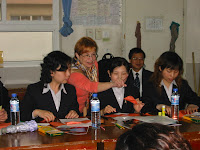 Believe it or not, today was our last full day in China. We left early this morning for Suzhou, a medium-sized city of 7 million people located about two hours outside of Shanghai (yes, 7 million is medium-sized here). There is an expression in Chinese that says “Up in the heavens is paradise; down on earth are Hangzhou and Suzhou.” This is because these two cities are known to be paradise on earth. Together with Shanghai, these cities also make up the wealthiest area in China.
Believe it or not, today was our last full day in China. We left early this morning for Suzhou, a medium-sized city of 7 million people located about two hours outside of Shanghai (yes, 7 million is medium-sized here). There is an expression in Chinese that says “Up in the heavens is paradise; down on earth are Hangzhou and Suzhou.” This is because these two cities are known to be paradise on earth. Together with Shanghai, these cities also make up the wealthiest area in China. Suzhou is said to be the Venice of the East, as it is full of canals and bridges—168 to be exact. The city is also known for its amazing gardens. During the Qing dynasty, there were over 200 gardens in Suzhou. Over time, many have been destroyed leaving 70 gardens today (only 10 or so are open to the public). We learned that the Humble Administrator’s Garden, which we visited today, along with three other classical gardens in Suzhou have been named a UNESCO world heritage site. It was clear from our visit that this garden was a serene balance of water, hills, beautiful architecture, winding pathways, and peaceful corners in which to rest, meditate, and engage with nature. We were amazed by our visit and could have stayed all day—but the silk factory was calling!
Suzhou is said to be the Venice of the East, as it is full of canals and bridges—168 to be exact. The city is also known for its amazing gardens. During the Qing dynasty, there were over 200 gardens in Suzhou. Over time, many have been destroyed leaving 70 gardens today (only 10 or so are open to the public). We learned that the Humble Administrator’s Garden, which we visited today, along with three other classical gardens in Suzhou have been named a UNESCO world heritage site. It was clear from our visit that this garden was a serene balance of water, hills, beautiful architecture, winding pathways, and peaceful corners in which to rest, meditate, and engage with nature. We were amazed by our visit and could have stayed all day—but the silk factory was calling! In addition to being known for gardens, Suzhou is also famous for its high-quality silk. Our group visited the Number 1 silk factory in the region and learned all about the silk-making process. We were most amazed by how machines and human workers are able to take individual cocoons and unravel the silk into long threads. We were further struck by how many threads are needed to produce the products we most enjoy, such as scarves, bags, and clothes. We learned that it takes 600 cocoons to make a 1 meter2 scarf; 10,000 cocoons to make a king-sized silk quilt. After visiting this factory, we had a deeper appreciation for the process and for the beauty of this fine fabric.
In addition to being known for gardens, Suzhou is also famous for its high-quality silk. Our group visited the Number 1 silk factory in the region and learned all about the silk-making process. We were most amazed by how machines and human workers are able to take individual cocoons and unravel the silk into long threads. We were further struck by how many threads are needed to produce the products we most enjoy, such as scarves, bags, and clothes. We learned that it takes 600 cocoons to make a 1 meter2 scarf; 10,000 cocoons to make a king-sized silk quilt. After visiting this factory, we had a deeper appreciation for the process and for the beauty of this fine fabric.
At the end of the day, we gathered together one last time for a final celebration. We listened to classical Chinese music, feasted on duck, sticky rice, and fresh corn, and reminisced about an unforgettable trip. We are so appreciative of this opportunity to not only visit China, but to feel, touch, smell, and taste all that China has to offer. The more we live these experiences here, the more we see endless opportunities for sharing these stories with our students. These teachers’ classrooms will never be the same again. Their curricula will be forever enriched by real-life experiences, cultural artifacts, and personal anecdotes from their time here in China. I feel a sense of profound satisfaction and pride knowing that thousands of students will be impacted by the lessons learned on this study tour. We have truly appreciated how thoughtful and hardworking these teachers have been on this trip—their dedication to their craft and to continued learning is an inspiration.
We hope to maintain this blog at least for a couple of months to show how the teachers are using their experiences and planning their curricular changes for the new year. We hope you will continue to check back from time to time to follow their progress.
It is with a heavy heart that we say, “Zai jian,” (goodbye) to China. We hope to see you again very soon.
Today’s Interesting Tidbit: It takes a silkworm 7 days to spin a 1 km long thread of silk. Most silkworms only live 60 days.
Photos: 1. Group at the Humble Administrator’s Garden, 2. View from the garden, 3. Machine to unravel the silk from the cocoon, 4. Musical performance at our final dinner.













































